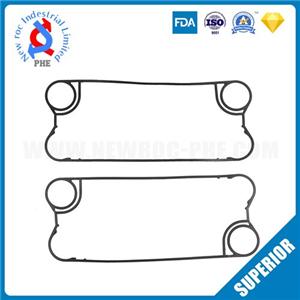The technology of fixing and replacing the gasket of plate heat exchanger
Plate heat exchanger is an important equipment in heat exchange technology in process industry equipment. The elastic heat exchanger gasket that seals between the various heat exchanger plates is a vulnerable part, and it is also a part that is prone to aging under natural conditions. Its service life has an important influence on the service life of the plate heat exchanger. If these heat exchanger gaskets are thermally hardened and lose their original elasticity, the heat exchanger may not work properly.
1. Fixation of heat exchanger seals:
In principle, the fixation of heat exchanger seals is divided into two categories: adhesive fixation and non-adhesive fixation. The shape of the heat exchanger gasket should be consistent with the shape of the plate heat exchanger seal. It must be pointed out that the adhesive fixing method does not have any effect on the sealing function.
(1) Non-adhesive heat exchanger sealing
Put the sealing ring in place: make the sealing ring enter the sealing groove correctly and press tightly: in the sealing groove, there is a groove-shaped structure with a gradually decreasing cross-section, so that the sealing ring can be positioned correctly.
(2) Adhesive heat exchanger sealing
According to the purpose of use of the heat exchanger gasket and the quality requirements of the heat exchanger, glue from different manufacturers can be used. Before bonding, air flow should be used to thoroughly remove the remaining adhesive on the bonding surface and the remaining heat exchanger gasket. For the bonding of the blended sealant, the residual adhesive on the bonding surface of the plate heat exchanger and the residual heat exchanger gasket must be burned out with fire. When bonding in large quantities, a liquid nitrogen tank for freezing seals should be prepared, and a heating furnace for drying plate heat exchangers with gaskets should be prepared. The heating temperature should reach 160°C. If possible, plate type heat exchangers should be prepared. The heat exchanger is chemically cleaned to ensure that the gaskets of the adhesives remaining in the bonding surface of the plate heat exchanger are completely removed.
2. Replacement of heat exchanger seals:
(1) Inspection and testing of reuse performance. When rust is suspected, check the wall thickness of the heat exchanger and pipes.
(2) Remove the aging heat exchanger seals. According to different dirt, use acid-alkali cleaning tank for chemical cleaning. The surface of the cleaned parts will not be corroded by chemical media (such as gasoline).
(3) After the chemical cleaning, use a high-pressure blowing device to thoroughly remove the chemical media remaining on the surface of the plate heat exchanger plates and other surfaces.
(4) Each heat exchanger plate is coated with a fluorescent test agent, and inspected for small cracks and corrosion holes under the irradiation of ultraviolet light, and cleaned again. In addition, check the condition of the seal groove and repair it if necessary.
(5) For the adhesive gasket, the residual material will be completely removed, and the blended adhesive will be used to re-bond, and the re-assembled heat exchanger sheet set will be clamped in a special fixture to solidify the adhesive; Heat and keep in the furnace to achieve good bonding effect. For non-adhesive heat exchanger gaskets, different devices are used to fix the gaskets in the heat exchanger plates.
(6) Inspect the bonding position and bonding quality of each heat exchanger sheet, classify them in the order of installation, and then carefully assemble the heat exchanger sheet group.




